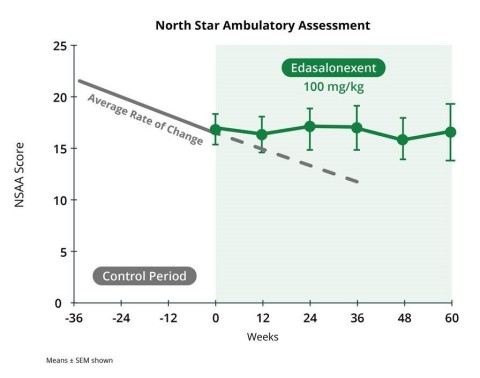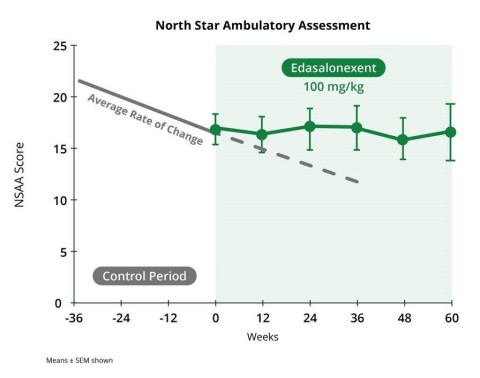CAMBRIDGE, Mass.--(BUSINESS WIRE)--Catabasis Pharmaceuticals, Inc. (NASDAQ:CATB), a clinical-stage biopharmaceutical company, today reported new positive efficacy and safety results showing preservation of muscle function and sustained disease-modifying effects in boys with Duchene muscular dystrophy (DMD) in the MoveDMD trial open-label extension following 48 and 60 weeks of treatment with edasalonexent. Consistent improvements in all assessments of muscle function were observed after more than a year of oral 100 mg/kg/day edasalonexent treatment compared to the rates of change in the pre-specified control period for boys prior to receiving edasalonexent treatment. Additionally, supportive changes in non-effort based measures of muscle health were seen, with significant longer-term reductions in muscle enzymes and C-reactive protein (CRP), supporting the durability of edasalonexent treatment effects. Edasalonexent continued to be well tolerated with no safety signals observed in the trial. These data will be presented on Saturday, February 17, 2018, at 14:15 CET at the XVI International Conference on Duchenne and Becker Muscular Dystrophy in Rome, Italy, and detailed at future scientific conferences.
Catabasis plans to initiate a single global Phase 3 trial with edasalonexent in patients with DMD regardless of mutation type in the first half of 2018 with top-line results expected in 2020. Edasalonexent is a potential oral foundational therapy that is being developed for all patients affected by DMD.
“We are thrilled to see this preservation of muscle function and substantial slowing of disease progression in boys following more than a year of edasalonexent treatment. This effect has the potential to be extremely impactful for boys affected by Duchenne,” said Jill C. Milne, Ph.D., Chief Executive Officer of Catabasis. “Building on the results previously reported for edasalonexent treatment in patients up to 36 weeks, these new data at 48 and 60 weeks show that edasalonexent continued to slow progression of the disease. We look forward to advancing edasalonexent in a single global Phase 3 trial later this year with the goal of improving the quality and length of life for those affected by Duchenne.”
“As this study matures and we see the effect of edasalonexent treatment through 48 and 60 weeks, it is compelling that all of the assessments of muscle function are demonstrating stabilization at an age when boys with DMD have a predictable decline,” said Richard Finkel, M.D., Chief, Division of Neurology, Department of Pediatrics at Nemours Children’s Health System and a Principal Investigator for the study. “Clinically meaningful changes are observed here. The coherence of these data is very promising and I look forward to continuing to investigate edasalonexent in the Phase 3 trial as a potential therapy for the many boys affected by this devastating disease.”
In Phase 2 and the open-label extension of the MoveDMD trial, a preservation of muscle function and slowing of DMD disease progression was seen in boys treated with edasalonexent compared to the rates of change during the control period prior to receiving edasalonexent. Through 60 weeks of treatment, the 100 mg/kg/day treatment group showed consistent and clinically meaningful improvements in rates of decline compared to rates of change during the control period across all four assessments of muscle function: the three timed function tests (10-meter walk/run, 4-stair climb and time to stand), as well as the North Star Ambulatory Assessment (NSAA), an integrated global assessment of muscle function. Control period changes were measured prior to boys receiving edasalonexent, either prior to Phase 2 or during Phase 2 prior to treatment in the open-label extension for those in the placebo group, for time periods averaging 39 weeks. In the 100 mg/kg/day treatment group, 16 boys commenced edasalonexent either at the beginning of Phase 2 or at the beginning of the open-label extension. At the time of this most recent open-label extension data analysis on functional assessments, all 13 boys continuing to participate had received 100 mg/kg/day for 48 weeks and 8 had reached 60 weeks of 100 mg/kg/day edasalonexent treatment.
Additional supportive measures of muscle health also reinforce positive edasalonexent treatment effects in the 100 mg/kg/day treatment group. Four muscle enzymes (creatine kinase, alanine aminotransferase, aspartate aminotransferase and lactate dehydrogenase) were significantly decreased compared to baseline following edasalonexent treatment at 12 weeks and later time points through 60 weeks (p<0.05), consistent with the ability to slow muscle degeneration and improve muscle integrity. Biomarker results showed that CRP was significantly decreased with edasalonexent at 12, 24, 36 and 48 weeks compared to baseline in the 100 mg/kg/day treatment group (p≤0.001). CRP is a well-characterized blood test marker that provides a global assessment of inflammation, and CRP is elevated in boys affected by DMD. The significant decrease observed in CRP supports the biological activity of NF-kB inhibition by edasalonexent treatment decreasing inflammation.
Edasalonexent continued to be well tolerated with no clinical safety signals observed to date. The majority of adverse events (AEs) have been mild in nature with no serious AEs. The most common related AEs were gastrointestinal, primarily mild and transient diarrhea. Boys with DMD in this age range typically have resting tachycardia, a heart rate that exceeds the normal resting rate, and the heart rate of the boys treated with edasalonexent decreased toward age-normative values during treatment.
Catabasis plans to initiate a single global Phase 3 trial in DMD in the first half of 2018 to evaluate the efficacy and safety of edasalonexent for registration purposes. The design of the randomized, double-blind, placebo-controlled trial has been informed by discussions with FDA and EMA. The Phase 3 trial is expected to have many key elements in common with the Phase 2 trial, including the patient population and functional endpoints. Catabasis anticipates enrolling approximately 125 patients between their 4th and 7th birthday who have not been on steroids for at least 6 months. Boys on a stable dose of eteplirsen may be eligible to enroll. The primary efficacy endpoint will be change in the North Star Ambulatory Assessment score after 12 months of treatment with edasalonexent compared to placebo. Key secondary endpoints are planned to include age-appropriate timed function tests. Assessments of growth, cardiac and bone health are also planned to be included. Catabasis expects to report top-line results from this trial in 2020.
About the MoveDMD Trial
The MoveDMD trial is
investigating the safety and efficacy of edasalonexent
in steroid-naïve boys enrolled at ages 4 – 7 affected with DMD (any
confirmed mutation). The trial is comprised of three parts - Phase 1,
Phase 2 and open-label extension. Phase 2 was a randomized,
double-blind, placebo-controlled 12-week portion with 31 ambulatory boys
across a range of dystrophin mutations. The 12-week MRI T2 primary
endpoint for treated boys compared to placebo was directionally positive
although not statistically significant. The open-label extension
evaluated longer term safety and efficacy using pre-specified analyses
comparing the rates of change in boys receiving edasalonexent treatment
and prior to treatment. In the Phase 2 and open-label extension of the
MoveDMD trial, edasalonexent substantially slowed DMD disease
progression in boys on 100 mg/kg/day through 60 weeks of treatment.
Across all assessments of muscle function, consistent improvements were
observed in the rate of decline after 12, 24, 36, 48 and 60 weeks of
oral 100 mg/kg/day edasalonexent treatment compared to the rate of
change in the control period for boys prior to receiving edasalonexent
treatment. Statistically significant improvements were also seen across
available non-effort based measures of muscle health. In the 100
mg/kg/day treatment group, 16 boys commenced edasalonexent either at the
beginning of Phase 2 or at the beginning of the open-label extension.
Edasalonexent was well tolerated with no safety signals observed in the
trial. Catabasis expects to present additional data at scientific
meetings in 2018.
About Edasalonexent (CAT-1004)
Edasalonexent (CAT-1004) is
an investigational oral small molecule that is being developed as a
potential disease-modifying therapy for all patients affected by DMD,
regardless of their underlying mutation. Edasalonexent inhibits NF-kB, a
protein that is activated in DMD and drives inflammation and fibrosis,
muscle degeneration and suppresses muscle regeneration. Edasalonexent
continues to be dosed in the open-label extension of the MoveDMD Phase 2
clinical trial and Catabasis plans to initiate a single global Phase 3
trial to evaluate the efficacy and safety of edasalonexent for
registration purposes in the first half of 2018. The FDA has granted
orphan drug, fast track and rare pediatric disease designations and the
European Commission has granted orphan medicinal product designation to
edasalonexent for the treatment of DMD. For a summary of clinical
results reported to-date, please visit www.catabasis.com.
About Catabasis
At Catabasis Pharmaceuticals, our mission is
to bring hope and life-changing therapies to patients and their
families. Our SMART (Safely Metabolized And Rationally Targeted) Linker
drug discovery platform enables us to engineer molecules that
simultaneously modulate multiple targets in a disease. We are applying
our SMART LinkerSM platform to build an internal pipeline of
product candidates for rare diseases and plan to pursue partnerships to
develop additional product candidates. For more information on the
Company's drug discovery platform and pipeline of drug candidates,
please visit www.catabasis.com.
Forward Looking Statements
Any statements in this press
release about future expectations, plans and prospects for the Company,
including statements about future clinical trial plans including, among
other things, statements about the Company’s plans to commence a single
global Phase 3 trial in DMD in the first half of 2018 to evaluate the
efficacy and safety of edasalonexent for registration purposes, the
Company’s plans to report top-line results from this trial in 2020, and
other statements containing the words “believes,” “anticipates,”
“plans,” “expects,” “may” and similar expressions, constitute
forward-looking statements within the meaning of the Private Securities
Litigation Reform Act of 1995. Actual results may differ materially from
those indicated by such forward-looking statements as a result of
various important factors, including: uncertainties inherent in the
initiation and completion of preclinical studies and clinical trials and
clinical development of the Company’s product candidates, including the
final trial design of the Company’s planned Phase 3 trial in DMD;
availability and timing of results from preclinical studies and clinical
trials, including the availability of top-line results from the
Company’s planned Phase 3 trial in DMD in 2020; whether interim results
from a clinical trial will be predictive of the final results of the
trial or the results of future trials; expectations for regulatory
approvals to conduct trials or to market products; the Company’s ability
to obtain financing on acceptable terms and in a timely manner to fund
the Company’s planned Phase 3 trial of edasalonexent in DMD for
registration purposes; availability of funding sufficient for the
Company’s foreseeable and unforeseeable operating expenses and capital
expenditure requirements; other matters that could affect the
availability or commercial potential of the Company’s product
candidates; and general economic and market conditions and other factors
discussed in the “Risk Factors” section of the Company’s Quarterly
Report on Form 10-Q for the period ended September 30, 2017, which is on
file with the Securities and Exchange Commission, and in other filings
that the Company may make with the Securities and Exchange Commission in
the future. In addition, the forward-looking statements included in this
press release represent the Company’s views as of the date of this press
release. The Company anticipates that subsequent events and developments
will cause the Company’s views to change. However, while the Company may
elect to update these forward-looking statements at some point in the
future, the Company specifically disclaims any obligation to do so.
These forward-looking statements should not be relied upon as
representing the Company’s views as of any date subsequent to the date
of this release.




